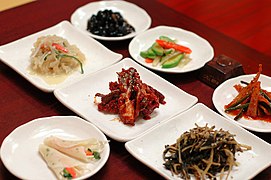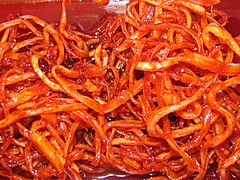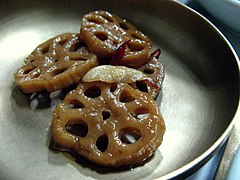Banchan
| Banchan | |
|---|---|
| country | Korea |
| Type of dish | Side dishes |
| Korean names | |
| Hangeul | 반찬 |
| Hanja | 飯 饌 |
| pronunciation | pan.tɕʰan |
| Revised Romanization | Banchan |
| McCune-Reischauer | Panch'an |
Banchan ( pan.tɕʰan , Kor. 반찬 , Hanja 飯 饌 , rev. Banchan ) in Korean cuisine refers to vegetable side dishes that are served with boiled rice . The word describes both the individual supplement (singular) and the supplement as a whole (plural).
introduction
The basic composition of a court, which Bansang (반상) is called, usually consists of cooked rice ( bap , 밥), soup ( Guk , 국; sometimes Tang kor. 탕 , Hanja 湯 called), a sharp, spicy paste ( Gochujang ) or soy sauce ( ganjang ), kimchi , and a main course, which is often a braised stew ( jjigae ). Depending on how many of the side dishes are served, one speaks in Korea of 3 Cheop (삼첩), 5 Cheop (오첩), 7 Cheop (칠첩), 9 Cheop (구첩) or 12 Cheop (십 이첩) Bansang . 12 Cheop was the common standard at the royal court during the Joseon Dynasty (1392-1897).
Banchan is served in small bowls that are placed in the center of the table so that everyone at the table can eat from it. This is also where the main component of the meal is placed, e.g. B. Korean barbecue ( Galbi ) , Bulgogi or a stew ( Jjigae ). On the other hand, each guest receives a bowl of boiled rice and a soup ( guk ) separately.
The province of Jeolla in particular is famous for the fact that a particularly large number of different banchan are served during one meal .
history
It is believed that Banchan goes back to the Buddhist influence, around the middle of the Three Kingdoms period (approx. 100 BC - 500 AD). Due to Buddhist influence, it was forbidden to eat meat in the kingdoms. Because of the ban, Korean cuisine developed a rich tradition of vegetarian dishes. At the royal courts in particular, a large number of options have been developed to compose and serve vegetarian dishes in an elaborate and appealing way. A less elaborate kitchen tradition developed in less affluent sections of the population.
With the Mongol invasions in Korea , both the ban on meat dishes and the ban on animal sacrifices in death rituals ( Isaiah ) fell. However, about 600 years of vegetarian cuisine had already had a lasting impact on Korean cuisine.
variants
Kimchi

Kimchi (김치) are vegetables fermented with lactic acid bacteria , usually Chinese cabbage ( 배추; Baechu ), seasoned with chilli and salt . It is the key banchan of almost every Korean meal. For some Koreans, eating without kimchi is not a real meal. Kimchi can also be made from other vegetables, such as B. Spring onions , brown mustard (갓), and radish (무; mu ).
| Surname | Korean name | description |
|---|---|---|
| Nabak kimchi | 나 박김치 | Water Kimchi with less spicy Chinese cabbage (Baechu) and radish (Mu) |
| Dongchimi | 동치미 | Various vegetables soaked in a brine . Nabak kimchi and dongchimi are both also known as water kimchi (Mul Kimchi, 물 김치). |
| Geotjeori | 겉절이 | Freshly set kimchi that is still crisp and not yet fermented. Mostly prepared Chinese cabbage (Baechu) and lettuce . |
| Kkakdugi | 깍두기 | A kimchi based on diced Korean white radish (mu) . |
| Oi Sobagi | 오이 소박이 | Stuffed cucumber kimchi , filled with chilli, spring onions and Chinese chives ( buchu ) |
| Chonggak Kimchi | 총각 김치 | Whole radishes ( mu ) pickled in chili. The kimchi is made from dallangmu , a type of radish that is about the size of small sausages. |
| Yeolmu Kimchi | 열무 김치 | Young summer radish kimchi . The radish is harvested early, before it is ripe. It can be prepared with or without fermentation. Usually prepared together with seafood ( Jeotgal ). |
| Pa kimchi | 파김치 | Onion kimchi, spicy, very salty and often mixed with an anchovy preparation ( Myeolchi-Jeot ). |
| Gat kimchi | 갓김치 | Kimchi made from Indian mustard leaves and with lots of paprika powder. With a characteristic bitter taste and aroma. To soften the bitter taste, a paste made from sticky rice flour and anchovy preparation is sometimes added. |
Namul

Namul (나물) are steamed, marinated or seared vegetables, usually prepared with sesame oil , salt, vinegar , finely chopped garlic , chopped young onions , dried chilli peppers, and soy sauce .
| Surname | Korean name | description |
|---|---|---|
| Kongnamul | 콩나물 | Cold boiled bean sprouts with sesame oil. |
| Sigeumchi Namul | 시금치 나물 | Poached spinach , dressed with sesame oil, garlic and soy sauce. |
| Miyeok Muchim | 미역 무침 | Miyeok ( wakame , a brown alga) with sweet vinegar and salt. |
| Musaengchae / Muchae | 무생채 / 무채 | Long , pinched radish in sweet vinegar sauce, sometimes with chili powder. |
| Gosari Namul | 고사리 나물 | Seared fern sprouts. |
| Chwinamul | 취나물 | A seared and seasoned aster . |
| Bireum Namul | 비름 나물 | Poached and seasoned amaranthus . |
| Naengi Namul | 냉이 나물 | Cooked and seasoned shepherd's purse . |
| Dolnamul | 돌나물 | Raw stonecrop with a pepper sauce dressing. |
| Gogumasun Namul | 고구마 순 나물 | Cooked and seasoned sweet potato - sprouts . |
| Gaji Namul | 가지 나물 | Boiled eggplant . |
| Doraji Namul | 도라지 나물 | Boiled roots of balloon flower . |
Bokkeum
Bokkeum (볶음) are various seared little things with sauce.
| Surname | Korean name | description |
|---|---|---|
| Kimchi Bokkeum | 김치 볶음 | Seared kimchi, often with pork (similar to Jeyook Bokkeum ). |
| Jeyook Bokkeum | 제육 볶음 | Seared pork with gochujang (chilli sauce) and onions. |
| Ojingeochae Bokkeum | 오징어 채 볶음 | Seared cut into fine strips dried squid ( squid or cuttlefish ), prepared with a mixture of red pepper paste ( Gochujang ) , garlic , and Mullyeot (a syrup-like condiments). |
| Nakji Bokkeum | 낙지 볶음 | Seared baby octopus in a spicy gochujang sauce. |
| Buseot Bokkeum | 버섯 볶음 | Fried mushrooms, e.g. B. Pyogo , oyster or Matsutake . |
Jorim
Jorim (조림) are foods cooked in a broth.
| Surname | Korean name | description |
|---|---|---|
| Dubu-Jorim | 두부 조림 | Tofu , simmered in a diluted soy sauce with sesame oil, finely chopped garlic and finely chopped spring onions. |
| Jang-Jorim | 장조림 | Beef cooked in soy sauce, optionally with hard-boiled eggs or hard-boiled quail eggs . |
Jjim
Jjim (찜) are steamed foods.
| Surname | Korean name | description |
|---|---|---|
| Gyeran-Jjim | 계란 찜 | Steamed whisked seasoned egg. |
| Saengseon Jjim | 생선 찜 | Steamed fish. |
Jeon
Jeon (전) are various pancake-like dishes. Alsocalled Buchimgae .
| Surname | Korean name | description |
|---|---|---|
| Pajeon | 파전 | Crepes with spring onions . |
| Kimchijeon | 김치전 | Crepes with old (ripe) kimchi . |
| Gamjajeon | 감자전 | Korean potato pancakes . |
| Saengseon-Jeon | 생선전 | Small pieces of fish, fried in an egg coat. |
| Donggeurang Ttaeng | 동그랑땡 | Pie made of tofu, meat and vegetables fried in an egg coat. |
Further
| Surname | Korean name | description |
|---|---|---|
| Danmuji | 단무지 | Radish marinated in a yellow marinade made from gardenia fruits. |
| Gyeran-Mari | 계란말이 | A rolled omelette that is served sliced. |
| Japchae | 잡채 | Japchae are glass noodles with various vegetables and beef in a slightly sweet garlic sauce. It can be eaten as an independent dish, but also in smaller quantities as a side dish ( Banchan ). |
| Korean potato salad | 감자 샐러드 | With apples and carrots. |
gallery
- Different banchan
Set table in Jeolla province with lots of banchan
Lotus root (Yeongeun Jorim) (연근 조림)
Sweet Potato Noodles ( Japchae )
See also
Individual evidence
- ↑ Aparita Bhandari: Learning how to eat banchan. thestar.com, March 22, 2017, accessed November 11, 2017 .
- ↑ 반상 차리기. Prepare the bansang. naver.com, accessed November 11, 2017 (Korean). , taken from the Doosan Encyclopedia .
- ↑ 한정식 (Hanjeongsik). Naver from a free collection by food critic Lee JinRang (이진랑), July 17, 2005, accessed November 12, 2017 (Korean).
- ↑ a b c d About Banchan. Hannaonetwo, accessed April 1, 2018 .
- ↑ Types of Kimchi. Korea Tourism Organization, archived from the original on January 5, 2013 ; accessed on November 12, 2017 (English).
- ↑ 겉절이. Doosan Encyclopedia, accessed November 12, 2017 (Korean).
- ^ Type of Kimchi. Kimchi Time, archived from the original on February 7, 2010 ; accessed on November 13, 2017 (English).
- ^ Korean Food: Seasoned Vegetables. Life in Korea, accessed November 12, 2017 .
- ↑ Suzy Chung: Herbivore's delight - Spring namul. Korea.net, April 10, 2012, archived from the original on April 30, 2013 ; accessed on November 12, 2017 (English).
- ↑ Maangchi: Spinach side dish. maangchi.com, September 30, 2007, accessed November 12, 2017 .
- ↑ Ji Sook Choe, Yukiko Moriyama: Quick and Easy Korean Cooking for Everyone . Japan Publications Trading Company, 2003, ISBN 978-4-88996-124-9 ( google.hu [accessed November 13, 2017]).
- ↑ 무생채 (Musaengchae). Doosan Encyclopedia, accessed November 12, 2017 (Korean).
- ↑ 비름 나물 고추장 무침. allrecipes.kr, archived from the original on October 5, 2013 ; Retrieved November 12, 2017 (Korean).
- ↑ Go-Gu-Ma-Sun Na-Mul, 고구마 순 나물, Seasoned Bellflower Roots. TriFood.com, accessed November 12, 2017 .
- ↑ a b c Korean Food: Stir-fried Dishes. Life in Korea, accessed November 13, 2017 .
- ↑ Jae-yook (Kim-Chi) Bo-kum Spicy Pork and Kimchi Stirfry, 제육 (김치) 볶음. TriFood.com, accessed November 13, 2017 .
- ↑ 오징어 채 볶음 (Ojingeochae Bokkeum). Doosan Encyclopedia, accessed November 13, 2017 (Korean).
- ↑ 두부 조림 (dubu jorim / Braised Pan-Fried Tofu). Doosan Encyclopedia, accessed November 14, 2017 (Korean).
- ↑ Jang-jo-rim, Flavored Beef Brisket, 장조림. TriFood (The free Dictiaonary Food), accessed November 14, 2017 .
- ↑ (미스터 M 의 사랑 받는 요리) 계란 찜. (Mr. M's favorite dish) Steamed egg. Sports Khan, March 13, 2013, accessed November 14, 2017 (Korean).
- ↑ Saengseon Jjim Braised Fish With Radish in Seasoned Soy Sauce. The Korea Times, January 7, 2010, accessed November 14, 2017 .
- ↑ a b c Naomi Imatome-Yun: The Variety of Korean Savory Pancakes: A List. Why Korean pancakes are more versatile than the American counterpart. thespruce.com, April 3, 2017, accessed November 13, 2017 .
- ↑ 감자전. Dong A, archived from the original on February 27, 2004 ; Retrieved November 14, 2017 (Korean).
- ↑ Saengseon Jeon (Pan-Grilled Fish With Egg). Korea Times, December 10, 2009, accessed November 14, 2017 .
- ↑ 동그랑땡. Dong-A Woman, December 22, 2006, accessed November 14, 2017 (Korean).
Web links
- Korean Cuisine. 1stopkorea.com, accessed November 11, 2017 .
- The characteristics of Korean food. University of Florida , accessed November 11, 2017 .







